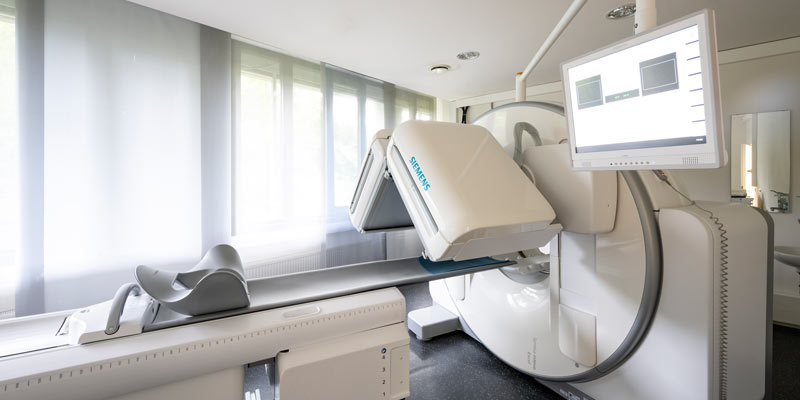To the performance overview
Radio-ligand-therapy (PSMA)
Lu177-PSMA therapy
RLT (radio-ligand therapy) of therapy-refractory (prostate carcinoma no longer responds to hormone therapy), metastasised prostate carcinomas with lutetium-177 PSMA.
Prof. R.P. Baum performed the world’s first therapy with Lu177-PSMA for prostate cancer and has successfully treated thousands of patients with this method. Since Prof. R. P. Baum joined us, we also offer cancer therapies with Lu177-DOTATOC for neuroendocrine tumors.
1. Which tumors can be treated?
All metastases can be treated that have PSMA (prostate specific membrane antigen) on the surface of the cancer cell. This is determined by PSMA PET/CT (positron emission tomography), a necessary preliminary examination which is carried out in our practice in previously. PET/CT makes it possible to precisely determine the number of docking sites for the subsequent therapy on the tumor cells/metastases based on so-called uptake values (SUV) and thus to predict whether Lu177 therapy makes sense at all and with what probability success can be achieved: THERANOSTICS principle – irradiation is targeted to what is previously visible in PET/CT.
2. Mode of action of lutetium-177 PSMA therapy
Radio-ligand therapy (RLT) is used for the nuclear medical treatment of PSMA-positive, mostly hormone-resistant metastases or tumor recurrences that no longer respond to other treatment methods (hormone therapy, percutaneous radiotherapy or chemotherapy). A molecule labelled with the beta emitter Lu-177 (ligand, PSMA inhibitor) is used for this purpose. The range of the beta emitter lutetium-177 in the tissue is approx. 2 mm, but also very large tumors can be treated, as the molecule penetrates into practically every tumor depth. Healthy tissue is spared as far as possible.
The molecule labelled with the beta emitter is applied into a vein in the arm and accumulates very quickly in the metastases or tumor recurrences previously detected by the PSMA PET/CT or also in the primary tumor – what is previously visible in the PET/CT is also irradiated – as you say in English “we see what we treat”. The therapy effect thus depends on the storage intensity in the PET/CT. The therapy emitter destroys the DNA of the tumor cells, which causes the tumor findings to regress (in approx. 70 %) or at least to slow down their growth (in approx. 15 %). In a few cases, the tumour cells are destroyed.
3. Course of therapy
The duration of inpatient admission to the DKD is 2 to 3 days. During your inpatient stay, you are unfortunately not allowed to receive visitors or leave the ward for radiation protection reasons. However, you will have regular contact with doctors, nursing staff and, of course, your fellow patients. You will also have access to telephone, television, and internet connection (WLAN).
Before the therapy is carried out, the necessary examinations are made (laboratory control including PSA determination, whole-body PSMA PET/CT, possibly kidney or salivary gland scintigraphy, sonography, urological presentation). The examination results are discussed in detail before treatment.
On the day of therapy, at least 1.5 litres of fluid must be drunk to keep the radiation exposure as low as possible (accelerated excretion). The therapy substance lutetium-177 PSMA is administered intravenously via a vein in the arm and only takes a few minutes. The excess therapy substance which did not dock to the metastases/tumors is predominantly excreted renally. Infusion therapy (parenteral fluid administration) is given to reduce renal stress. Nausea occurred extremely rarely after therapy.
After injection of the therapy substance, the patient must remain on the therapy ward for 48 hours (this is a legal requirement that cannot be negotiated).
The control of the accumulation intensity in the metastases as well as measurements of the degradation of the therapy substance in the rest of the body are carried out in the practice for nuclear medicine as scintigraphic whole-body images as well as by a SPECT/CT (tomography/slice examination) of the tumor regions.
The therapy is usually repeated after 8 to 12 weeks. Before a new course of therapy, a PSMA-PET/CT may be performed to monitor the success.

4. Potential side effects
The number of red blood cells (erythrocytes), blood platelets (thrombocytes) and white blood cells (leucocytes) may decrease. Therefore, the blood count must be checked at certain intervals after the therapy. Even after repeated therapy, there is usually no restriction of kidney function; renal function is monitored. Due to accumulation in the lacrimal and salivary glands, radiogenic sialadenitis (dry mouth) may occur (this has been observed only rarely). Allergic reactions may (theoretically) occur during administration (never observed so far). Long-term side effects or harmful long-term effects have not occurred/are not known so far.
5. The therapy cannot be used for the following diseases:
– Acute infections with fever
– Severe bone marrow insufficiency
– Severe renal insufficiency
– Heart attack within the last 6 weeks
– Rapidly progressive secondary malignancies
Contact: Prof. Dr. med. Richard P. Baum, CURANOSTICUM Wiesbaden-Frankfurt
E-mail: baum@curanosticum.de
Publications (Sample)
Baum RP, Kulkarni HR, Volkmer B, Bohuslavizki KH, Schuchardt C, Klette I, Singh A, Wester HJ
Theranostik des metastasierten Prostatakarzinoms mittels Lu-177 PSMA-Liganden in Kombination mit Ga-68 PSMA PET/CT
Nuklearmediziner 2015; 38:145-152
Baum RP, Kulkarni HR, Schuchardt C, Singh A, Wirtz M, Wiessalla S, Schottelius M, Mueller D,Klette I, Wester HJ
177Lu-Labeled Prostate-Specific Membrane Antigen Radioligand Therapy of Metastatic Castration-Resistant Prostate Cancer: Safety and Efficacy
J Nucl Med. 2016l;57:1006-13
Kulkarni HR, Singh A, Schuchardt C, Niepsch K, Sayeg M, Leshch Y, Wester HJ, Baum RP
PSMA-Based Radioligand Therapy for Metastatic Castration-Resistant Prostate Cancer: The Bad Berka Experience Since 2013
J Nucl Med. 2016;57(Suppl 3):97S-104S
Kulkarni HR, Singh A, Langbein T, Schuchardt C, Mueller D, Zhang J, Lehmann C, Baum RP
Theranostics of prostate cancer: from molecular imaging to precision molecular radiotherapy targeting the prostate specific membrane antigen
Br J Radiol. 2018; 91(1091):20180308
Rahbar K, Ahmadzadehfar H, Kratochwil C, Haberkorn U, Schäfers M, Essler M, Baum RP, Kulkarni HR, Schmidt M, Drzezga A, Bartenstein P, Pfestroff A, Luster M, Lützen U, Marx M, Prasad V, Brenner W, Heinzel A, Mottaghy FM, Ruf J, Meyer PT, Heuschkel M, Eveslage M, Bögemann M, Fendler WP, Krause BJ
German Multicenter Study Investigating 177Lu-PSMA-617 Radioligand Therapy in Advanced Prostate Cancer Patients
J Nucl Med. 2017;58:85-90
Fendler WP, Kratochwil C, Ahmadzadehfar H, Rahbar K, Baum RP, Schmidt M, Pfestroff A, Lützen U, Prasad V, Heinzel A, Heuschkel M, Ruf J, Bartenstein P, Krause BJ
Therapie mit 177Lu-PSMA-617, Dosimetrie und Nachsorge beim metastasierten kastrationsresistenten Prostatakarzinom
Nuklearmedizin. 2016 Jun 28;55:123-8

